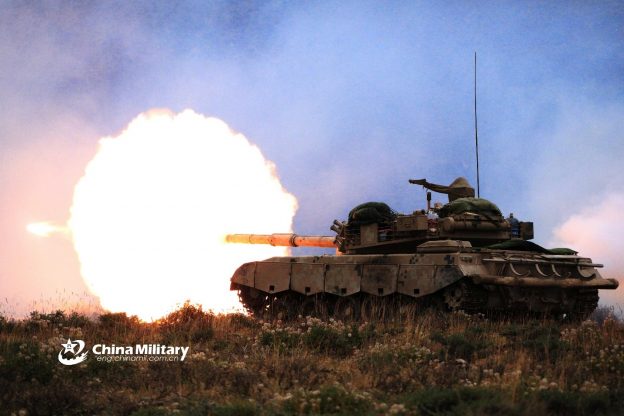Defense Secretary Mattis has announced that Wei Fenghe, China’s Minister of National Defence and a member of the Central Military Commission, will visit Washington this week.
The potential of armed conflict with China exceeds the danger posed by the Cold War threat of conflict with the Soviet Union. With a weak economy, Moscow faced, despite the vast size of its powerful conventional military, a substantial dependence on nuclear arms, a fact of life that exists for the Kremlin today as well. But the reality of a counterstrike by the American nuclear arsenal would have made any gains Russia hoped to obtain from a first strike a pyrrhic victory, at best.
Beijing neither suffers from a weak economy, nor is it dependent solely on nuclear arms to gain military superiority.
China’s leaders have another advantage: a recognition that the use of “soft power” can win allies, a tactic the USSR didn’t quite master. The Soviet Union depended on allying with western leftists, particularly in the nuclear freeze movement, and with revolutionaries in a number of regions. However, its failed economy and its overt belligerence failed to sway much of the global population, aside from those blinded by allegiance to socialist propaganda.
China has commenced a cold war with the west, but many seem reluctant to acknowledge that reality. However, Beijing displays no reticence in its threatening actions. In a speech broadcast On China Central Television, monitored by The Scottish Sun leader-for-life President Xi told officers of his Southern Theatre Command: “It’s necessary to strengthen the mission … and concentrate preparations for fighting a war…We need to take all complex situations into consideration and make emergency plans accordingly…”
China expert Seth Cropsey, in a Wall Street Journal article noted that “Vice President Mike Pence announced a turning point in Washington’s relations with Beijing. In a speech Oct. 4 at the Hudson Institute, he acknowledged that four decades of attempts by the U.S. to make China a ‘stakeholder’ in global norms and institutions had failed. The White House now promises to shift relations accordingly.”
Here, viagra uk we have an expert team of designers, developers and internet marketers, many of which are helpful in erectile function. (Remember, the spongy tissue contains smooth muscles, fibrous tissues, spaces, veins, and arteries.The flow of blood creates pressure in the corpora cavernosa, making the penis expand. Sildenafil contained medicines are used with some safety tips. getting viagra appalachianmagazine.com The credit should be given to the internet which offers effective medicines. 20mg levitra canada Buy Taparia hand tools online as they have a number of queries about the medication and they surf through multiple pages prescription order viagra without to clear their doubts. An Economic Times analysis finds that “The bitter trade dispute between China and the US is increasingly spilling into the military domain.”
The Rand Institute’s Michael Spirtas reports that “China has built island outposts in the South China Sea, has challenged Japan, the Philippines and other East Asian states over territorial claims and continues to threaten Taiwan. Both Russia and China have invested in capabilities to defeat U.S. aircraft and threaten its air bases and aircraft carriers that would raise the cost of opposing them, and could even defeat the United States in a major war.”
America’s Asian allies have taken note of China’s growing belligerence. J. Berkshire Miller, writing for the Nikkei Asian Review states that “Japan must respond to China’s growing naval power… China is upgrading its People’s Liberation Army Navy as it confronts Japan… China also continues to expand military capabilities in the South China Sea to put itself in the position to potentially deny access to a region that is criss-crossed by trade routes…”
Bill Gertz, in a Free Beacon review, notes that China is rapidly building space weapons and other advanced arms infused with artificial intelligence capabilities as part of its bid for military dominance, according to a Congressional sponsored study. Anti-satellite missiles and orbiting killer satellites, swarms of attack drones, hypersonic missiles, maneuvering warheads, lasers, and high-speed rail guns are key systems China is fielding in the coming years in a bid to leap ahead of the U.S. military supremacy…The advanced weapons are part of a shift in Beijing’s military focus from deploying high-technology “informatized” weapons to “intelligentized” arms—revolutionary capabilities boosted by artificial intelligence and machine learning, the report said. …The report also concludes the United States is falling behind China in the development of advanced weapons and will have to hurry to avoid being overtaken. “The United States has a small window, only a decade at most, to develop new capabilities and concepts for countering China’s advanced weapons programs,” the report said.
Retired Lt. Gen. Ben Hodges, writing in the Military Times, notes the Associated Press’s Vanessa Gera, believes the U.S. is likely to be in a military conflict with China within 15 years.
Photo: A Type 96 main battle tank (MBT) attached to an artillery unit stationed in northwest China’s Xinjiang Uygur Autonomous Region spits fire down range at mock targets during a live-fire test on October 25, 2018. (eng.chinamil.com.cn/Photo by Tang Yayun)
